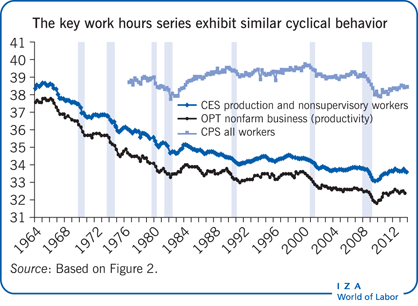Elevator pitch
Work hours are key components in estimating productivity growth and hourly wages as well as being a useful cyclical indicator in their own right, so measuring them correctly is important. The US Bureau of Labor Statistics (BLS) collects data on work hours in several surveys and publishes three widely-used series that measure average weekly hours. The series tell different stories about average weekly hours and trends in those hours but qualitatively similar stories about the cyclical behavior of work hours. The research summarized here explains the differences in levels, but only some of the differences in trends.

Key findings
Pros
On average, respondents to the BLS’s household survey correctly report weekly hours worked per person and weekly hours worked on their main jobs.
All three series exhibit similar cyclical behavior.
Differences in levels between the three series can be explained by differences in concepts and coverage.
All three series exhibit similar trends since the beginning of the 1990s.
Cons
There are significant differences between the three series in levels and trends, and the differences in long-term trends cannot be completely reconciled.
In the household survey, respondents under-report multiple jobholding and over-report hours worked on second jobs, but aggregate hours are approximately correct because these errors in reporting mostly offset each other.
Estimating annual work hours from average weekly hours overstates the annual number of hours worked, because the surveys’ reference periods exclude most holidays.
These results may not generalize to other countries because of differences in survey methods.